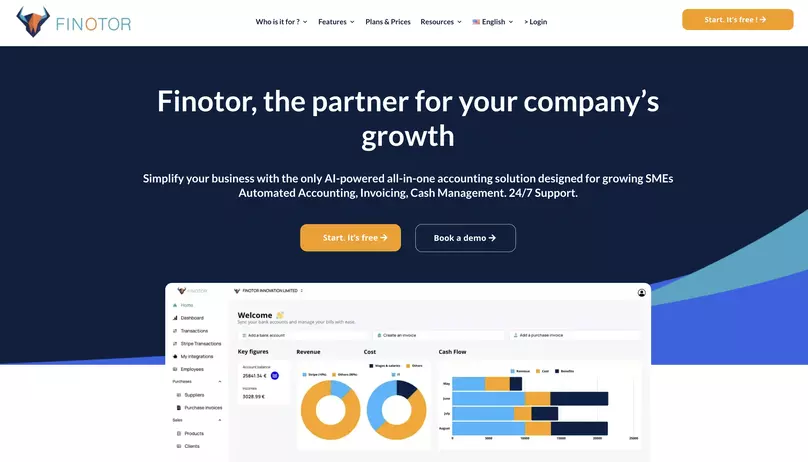Contents
- 1 What is cash management and budgeting ?
- 2 Why is cash management important for businesses ?
- 3 Analyse your income and expenses
- 4 Identifying your debts and savings
- 5 Determining your current net balance
- 6 Setting short and long term goals
- 7 Use the 50-30-20 rule
- 8 Make a plan to achieve your goals
- 9 Draw up a schedule for achieving the objectives
- 10 Setting a budget
Managing finances effectively is crucial to achieving short and long term goals, whether for a business or an individual. Creating a budget and managing cash flow are key elements of this management. However, it can be difficult to know where to start, especially if you don’t have a lot of experience with personal or business finances
That’s why we’ve written this article to provide you with practical steps for creating a budget and managing cash flow effectively. We will show you how to assess your current financial situation, define your financial goals, create a budget and manage your cash inflow and outflow. By following these steps, you will be well on your way to achieving your financial goals and improving your cash management
See the video online : https://youtu.be/2oss4R502q8?si=6LGeem330pO4QUVF
What is cash management and budgeting ?
Cash management is a key process for managing the finances of a business or individual. It involves planning and managing the flow of money in and out to ensure a balance between expenditure and income, and to avoid financial difficulties. Creating a budget is an important part of cash management. It allows you to plan future expenditure in relation to expected income, to avoid overspending and to achieve long-term financial goals
Why is cash management important for businesses ?
Cash management is is decisive for company management for businesses and individuals. For businesses, effective cash management can improve the ability to repay debts, invest in operations and projects, and increase profits. For individuals, good cash management can help avoid financial difficulties, pay off debts, save for future goals, and live a balanced life
1- Assessing your financial situation
Analyse your income and expenses
To begin creating a budget and managing cash flow effectively, it is important to understand your current financial situation. This involves taking an overview of your income and expenses, making a detailed list of all sources of income and categories of expenses
Identifying your debts and savings
It is also important to know what debts are outstanding and what savings are available. It is useful to list debts, such as credit cards, student loans and mortgages, as well as savings, such as savings accounts, investment accounts, etc
Determining your current net balance
Once income, expenses, debts and savings have been analysed, it is possible to determine your current net balance, which is the difference between your income and expenses. This net balance is an important indicator for assessing your current financial situation and setting goals for the future
2- Setting financial goals
Setting short and long term goals
Setting financial goals is one of the most important steps in effective cash management. It is essential to set both short-term and long-term goals to ensure that you are on track to achieve your long-term financial goals. Setting goals can include things like saving for a specific purchase, paying down debt or increasing your precautionary savings
Use the 50-30-20 rule
A popular technique for setting achievable financial goals is to use the 50-30-20 rule. According to this rule, 50% of your income should be spent on essential expenses, 30% on discretionary spending and 20% on savings and debt repayment. This helps to maintain a balance between spending and saving, while ensuring that you are able to pay off your debts on time
Make a plan to achieve your goals
Finally, it is important to set up a timetable for achieving these goals. This includes setting deadlines for achieving short-term goals, as well as deadlines for achieving long-term goals. By planning ahead and regularly monitoring progress towards your goals, you can ensure that you are on track to achieve your long-term financial goals
Draw up a schedule for achieving the objectives
Finally, it is important to set up a timetable for achieving these goals. This includes setting deadlines for achieving short-term goals, as well as deadlines for achieving long-term goals. By planning ahead and regularly monitoring progress towards your goals, you can ensure that you are on track to achieve your long-term financial goals
Setting a budget
- Developing a budget: The first step in creating a budget is to develop a budget table. This can be done using online budgeting software or spreadsheets. The important thing is to make sure you capture all income and expenses to get a complete picture of your financial situation.
- Tracking expenses: Once the budget is set, it is important to set up a tracking system to check actual expenses against the planned budget. This will allow deviations to be identified quickly and action taken to correct them.
- Adjustments: It is important to continue to adjust the budget in line with actual expenditure and financial targets. Unexpected expenses or changes in income can affect the budget and it is therefore necessary to continue to adjust it to ensure that it remains realistic and appropriate to the current financial situation.
3- Manage cash flow
A. Use a cash flow calendar to anticipate future financial needs. This can include invoice dates, salaries and upcoming payments
B. Analysing cash flow and planning strategies to improve it based on future financial needs. This may include finding new sources of income or measures to reduce expenses
C. Putting in place measures to minimise cash flow risks, such as setting up an emergency reserve or establishing a line of credit. These measures can help cover unexpected expenses and maintain financial stability
Conclusion
In conclusion, cash management and budgeting are key aspects of effective financial management for both businesses and individuals. Through the steps outlined in this article, we have seen how to assess your financial situation, set achievable financial goals, create a suitable budget and manage cash flow effectively. The techniques and tools presented in this article are concrete ways to achieve short and long-term financial goals
It is important to note that cash management requires continuous analysis and regular adjustments to maintain an optimal financial balance. Additional reading and resources to expand on the topics discussed in this article can also be helpful in continuing to improve financial management
We hope that this article has provided you with the information you need to start implementing effective cash management and budgeting systems with Finotor, but please feel free to consult the additional resources to further your knowledge.









